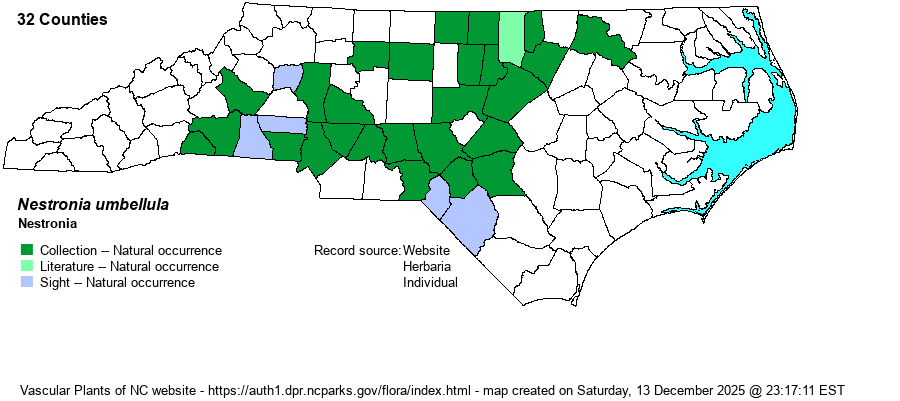| Author | Rafinesque | |
| Distribution | Throughout much of the Piedmont and upper Coastal Plain. Does not occur in the Mountains, or in the lower 2/3rds of the Coastal Plain. Seemingly absent from the northwestern corner of the Piedmont.
This is a Southern species found primarily in the Piedmont and upper Coastal Plain, from southern VA to southern GA, and west to eastern MS. It is found in just one KY county and is scattered in southeastern TN.
| |
| Abundance | Uncommon in the lower and central Piedmont and extreme upper Coastal Plain, including the Sandhills. Rare to very uncommon in the western Piedmont. At one time it was tracked by the NCNHP as a rare species, but later it was moved to the Watch List. As more populations have been found in recent years, it was taken off the Watch List – despite growing in habitats threatened by development. | |
| Habitat | In the Piedmont it occurs in dry to mesic hardwood or mixed forests, usually not where overly rocky nor overly sandy. It can occur near granitic flatrocks, and it also can be found on high pH soils of Basic Oak-Hickory Forest, but it is mainly in somewhat acidic soil forests. In the Coastal Plain, it occurs in somewhat more mesic forests, often on slopes or at upland ecotones next to pocosins or swamps. Where it occurs, it is usually found in large stands. |
| Phenology | Blooms in April and May; fruits (rarely seen) in July. | |
| Identification | This is a clonal deciduous shrub that grows to about 2-3 feet tall, and as a result, it is usually present in extensive colonies, in some places covering an acre or more. It is dioecious, such that male flowers are on separate plants from the female flowers. At a slight distance it can be easily confused with several blueberry or huckleberry species, as they often grow in extensive 2-3- feet-tall stands and have similar elliptical leaves that average 2 inches long. However, Nestronia has opposite leaves and branches, the twigs are dark purple-brown, and are very straight and stiff. Broken-off twigs are often seen. The flowers are rather small and greenish, but are helpful in identification in the spring. Sadly, because it is a clonal species, once a few individuals die, such as from disease, the whole population usually “blinks out” fairly quickly. | |
| Taxonomic Comments | None. This is a monotypic genus, and thus nothing is quite like Nestronia.
| |
| Other Common Name(s) | This is a species that has lacked a consistent, good common name. The genus name is often used, as in the case here. Other names include Indian Olive, Leechbrush, and Conjurer’s Nut. Of these, only Leechbrush has some merit, as it is a semi-parasitic shrub. This website would prefer to coin a new, original, and quite descriptive name: Brittle-twigs. | |
| State Rank | S3 | |
| Global Rank | G4 | |
| State Status | | |
| US Status | | |
| USACE-agcp | | |
| USACE-emp | | |

